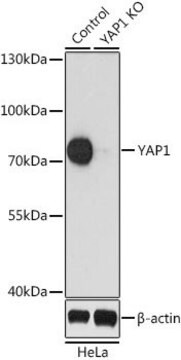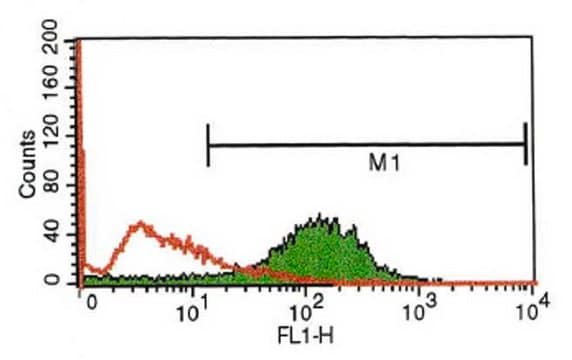E9653
Anti-Endothelial Cells antibody, Mouse monoclonal
clone P1H12, purified from hybridoma cell culture
Synonym(e):
Anti-CD146
About This Item
Empfohlene Produkte
Biologische Quelle
mouse
Konjugat
unconjugated
Antikörperform
purified immunoglobulin
Antikörper-Produkttyp
primary antibodies
Klon
P1H12, monoclonal
Form
buffered aqueous solution
Mol-Gew.
antigen 130 kDa
Speziesreaktivität
human
Methode(n)
flow cytometry: suitable using 2% paraformaldehyde 9:1 methanol
immunocytochemistry: suitable using 4% paraformaldehyde 0.1-0.5% triton X-100, smears or live cells
immunohistochemistry: suitable using using acetone-fixed sections of human tongue
immunoprecipitation (IP): suitable
indirect ELISA: suitable
microarray: suitable
Isotyp
IgG1
Versandbedingung
dry ice
Lagertemp.
−20°C
Posttranslationale Modifikation Target
unmodified
Allgemeine Beschreibung
Spezifität
Immunogen
Anwendung
- immunocytochemistry
- immunohistochemistry
- flow cytometry
- immunoprecipitation
- enzyme-linked immunosorbent assay (ELISA)
- western blotting
Biochem./physiol. Wirkung
Physikalische Form
Haftungsausschluss
Not finding the right product?
Try our Produkt-Auswahlhilfe.
Analysenzertifikate (COA)
Suchen Sie nach Analysenzertifikate (COA), indem Sie die Lot-/Chargennummer des Produkts eingeben. Lot- und Chargennummern sind auf dem Produktetikett hinter den Wörtern ‘Lot’ oder ‘Batch’ (Lot oder Charge) zu finden.
Besitzen Sie dieses Produkt bereits?
In der Dokumentenbibliothek finden Sie die Dokumentation zu den Produkten, die Sie kürzlich erworben haben.
Unser Team von Wissenschaftlern verfügt über Erfahrung in allen Forschungsbereichen einschließlich Life Science, Materialwissenschaften, chemischer Synthese, Chromatographie, Analytik und vielen mehr..
Setzen Sie sich mit dem technischen Dienst in Verbindung.








